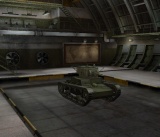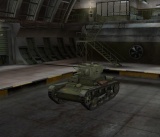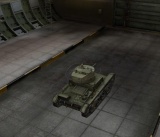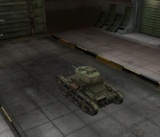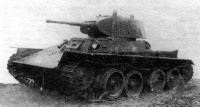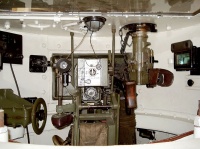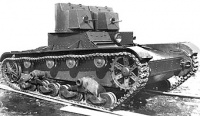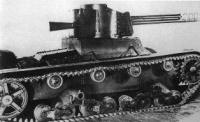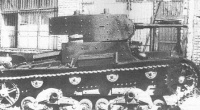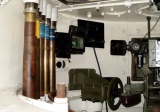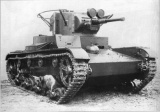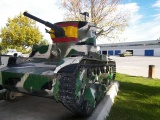T-26
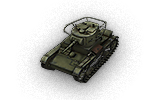
The T-26 is a Soviet tier 2 light tank. It is at the head of the medium and heavy tech tree branch, although both branches do eventually merge on the IS Heavy Tank. Only five tanks and one SPG are exclusive to this subbranch, but going down it puts you in a medium a tier earlier and a heavy almost twice as soon. The T-26 has armour only slightly better than that of the BT-2, which is not much to boast about (both are actually more lightly armoured than the MS-1 starter tank, in fact). The BT-2 gains impressive speed from this, while the T-26 has something else; very high track and turret traverse speeds. Stock, this is one of the nimblest tanks in the game, and it only gets better with the upgrades. When acquiring this tank, you should consider dropping the auto-cannon; this allows you to train yourself with single-shot type guns as they are more powerful than the auto-cannons, especially when facing Tier 3 and higher tanks. Try to play in a defensive stance or in a second line of defense, and avoid tanks such as the PzKpfw II or BT-2 near you as they will destroy this tank quickly with their mobility and superior firepower.
- The T-26 leads to the T-46.
T-26/ModulesT-26/EquipmentT-26/Consumables
Pros and Cons
Pros:
Cons:
- Below average engine power
- Below average top speed
Combat Effectiveness
Early Research
Historical Info
The T-26 tank was a Soviet light infantry tank used during many conflicts of the 1930s as well as during World War II. It was a development of the British Vickers 6-Ton tank and is widely considered one of the most successful tank designs of the 1930s. It was produced in greater numbers than any other tank of the period, with more than 11,000 produced. During the 1930s, the USSR developed approximately 53 variants of the T-26, including other combat vehicles based on its chassis. Twenty-three of these were mass-produced. The T-26 was used extensively in the armies of Spain, China and Turkey. In addition, captured T-26 light tanks were used by the Finnish, German, Romanian and Hungarian armies. Though nearly obsolete by the beginning of World War II, the T-26 was the most important tank of the Spanish Civil War and played a significant role during the Battle of Lake Khasan in 1938 as well as in the Winter War in 1939-40. The T-26 was the most numerous tank in the Red Army's armored force during the German invasion of the Soviet Union in June 1941. The Soviet T-26 light tanks last saw use in August 1945, in Manchuria. The T-26 was reliable and simple to maintain, and its design was continually modernised between 1931 and 1941, with a total of 11,218 vehicles built. However, no new models of the T-26 were developed after 1940.
Development history
The Soviets did not simply replicate the Vickers Six-Ton. Like its British counterpart, the T-26 mod. 1931 had a twin-turreted configuration and was designed to carry two machine guns, mounting one in each turret. A major difference between the Soviet T-26 mod. 1931 and the British 6-Ton were higher turrets on the T-26, complete with observation slit. Also Soviet turrets had a round firing port for the DT tank machine gun, as opposed to the rectangular ports used by the original British design for the Vickers machine gun. The front part of the hull was also slightly modified. Hulls of twin-turreted T-26s were assembled using armoured plates riveted to a frame from metal angles. Some tanks, produced in 1931, had sealing zinc shims at the hull bottom at the interface between armoured plates for fording water obstacles. After experiencing problems with precipitation entering the engine compartment, a special cover was installed over an air outlet window after March 1932. A number of T-26s produced at the end of 1932-1933 had a riveted and welded hull. The T-26 mod. 1931 had two cylindrical turrets mounted on ball bearings; each turret turned independently through 240°. Both turrets could provide common fire in front and rear arcs of fire (100° each). The disadvantage of such a configuration was the impossibility of focusing all of the tank's firepower on a single target. Four technological modifications of turrets existed, and they were mounted on tanks in different combinations (for instance, a tank with a riveted hull could have riveted and welded turrets). The hull and turrets of the T-26 mod. 1931 had a maximum armour thickness of 13-15 mm, which was sufficient to withstand a light machine gun fire. Nevertheless, many twin-turreted tanks of the first series had 10 mm armour plates of low quality, which could be penetrated by 7.62 mm armour-piercing bullets from 150 m. In 1938, the T-26 was upgraded to the model 1938 version which had a new conical turret with better anti-bullet resistance but the same welded hull as the T-26 mod. 1933 produced in 1935-1936. This proved insufficient in the Battle of Lake Khasan, which took place in 1938, so the tank was upgraded once more in February 1939 to have an underturret box with sloped (23°) 20 mm side armoured plates. The turret featured an increase to 20 mm at 18 degrees sloping. This time it was designated T-26-1 (known as the T-26 mod. 1939 in modern sources). There would be subsequent attempts to thicken the front plate, but T-26 production soon ended in favor of other designs, such as the T-34.
In 1933, the Soviets unveiled the T-26 mod. 1933. The Model 1933, with a new single cylindrical turret carrying one 45 mm cannon and one 7.62 mm machine gun, would become the most common T-26 variant. The 45 mm 20K tank gun was based on the German Pak 35/36 cannon acquired in 1930. The T-26 could carry up to three secondary DT 7.62 mm machine guns in coaxial, rear, and anti-aircraft mounts. This increased fire-power was intended to aid crews in defeating dedicated anti-tank teams, as the original machine gun armament had been found insufficient. The turret rear ball mounting for the additional DT tank machine gun was installed on the T-26 tanks from the end of 1935 until 1939. The T-26 Model 1933 carried 122 rounds of 45 mm ammunition, firing armour-piercing 45 mm rounds with a muzzle velocity of 820 m/s (2,700 ft/s), or lower-velocity high-explosive munitions. Tanks intended for company commanders were equipped with a radio set and a hand-rail radio antenna on the turret. Later the hand-rail antenna was replaced with a buggy-whip antenna, because theSpanish Civil War and Battle of Lake Khasan demonstrated that the hand-rail antenna unmasked commander tanks for enemy fire. The tank was powered by a T-26 90 hp (67 kW) flat row 4-cylinder air-cooled petrol engine which represented a Soviet full copy of the Armstrong Siddeley engine used in the Vickers 6-Ton. The engine was located in the rear part of the hull. In the beginning, Soviet-made tank engines were of bad quality; they were improved beginning in 1934. The T-26 (Armstrong Siddeley) engine did not have an over-speed limiter, which often resulted in overheating and engine valve breakage, especially in summer. A fuel tank for 182 liters and an oil box for 27 liters were placed alongside of the engine. The engine required top-grade petrol; the use of second-rate petrol could cause damage to the valve units because of engine detonation. From mid 1932, a more capacious fuel tank (290 L instead of 182 L) and a simplified oil box were introduced. An engine cooling fan was mounted over the engine in a special shroud. From spring 1932, the exhaust muffler was affixed by three clamps instead of two. The transmission of the T-26 consisted of single-disk main dry clutch, a gearbox with five gears in the front part of the vehicle, steering clutches, final drives and band brakes. The gearbox was connected to the engine by a drive shaft passing through the vehicle. A gear change lever was mounted directly on the gearbox. A tank suspension (for each side) consisted of two bogies, four rubber-covered return rollers, a track driving wheel and a track idler. Each bogie consisted of a cast box, four twin rubber-covered road wheels connected by balancing levers and two one-quarter elliptic leaf springs. The cast track driving wheel with removable sprocket ring was located in front, and the track idler with a crank lever tightener was located in the rear part of the vehicle. A track made from chrome-nickel steel was 260 mm (10 in) wide and consisted of 108-109 links. The T-26 mod. 1931 did not have a radio set. A tank commander communicated with the driver by speaking tube, which was replaced with a signalling lamp in 1932. The T-26 was equipped with one fire extinguisher, a kit of spare parts tools and accessories (including a tank jack), a canvas stowage, and a tow chain fixed on the rear of the hull. The T-26 could cross 0.75 m high vertical obstacles and 2.1 m wide trenches, ford 0.8 m deep water obstacles, cut 33 cm thick trees and climb 40° gradients. The T-26 proved to be easy to drive. Beginning in 1937, there was an effort to equip many tanks with a second machine gun in the rear of the turret and an anti-aircraft machine gun on top of it, as well as the addition of two searchlights above the gun for night gunnery, a new VKU-3 command system, and a TPU-3 intercom. Some tanks had vertically stabilised TOP-1 gun telescopic sight. Ammunition stowage for the main gun was improved from 122 rounds to 147. In 1938, the cylindrical turret was replaced with a conical turret, with the same 45 mm model 1934 gun. Some T-26s mod. 1938/1939, equipped with radio set, had a PTK commander's panoramic sight.
Combat history
The T-26 entered active service for the Red Army (RKKA) in 1932; it was used in many conflicts of 1930s as well as during World War II. The T-26 together with the BT was the main tank of the RKKA during the interwar period. The T-26 tank first saw action in the Spanish Civil War. The Soviet Union provided Republican Spain with a total of 281 T-26 mod. 1933 tanks starting in October 1936. T-26s were used in almost all military operations of the Spanish Civil War in 1936-1939 and demonstrated there a superiority over the German Panzer I light tanks and Italian CV-33 tankettes armed only with machine guns. The first military operation of the RKKA in which T-26 light tanks participated was the Soviet-Japanese border conflict, the Battle of Lake Khasan, in July 1938. The 2nd Mechanised Brigade, the 32nd and the 40th Separate Tank Battalions had 257 T-26s, from which 76 tanks were damaged and 9 burnt towards the end of battle action. A small number of T-26 tanks and flame-throwing tanks based on the T-26 chassis participated in the Battle of Khalkhin Gol in 1939. On the eve of World War II, T-26s served mainly in separate light tank brigades (each brigade had 256–267 T-26s) and in separate tank battalions of rifle divisions (one company of T-26s consisted of 10-15 tanks). This was the type of tank units that participated in the Soviet invasion of Poland in September 1939 and in the Winter War of December 1939-March 1940. The Winter War proved that the T-26 was obsolete and its design reserve was totally depleted. Finnish anti-tank guns easily penetrated the T-26's thin anti-bullet armour, and tank units equipped with the T-26 suffered significant losses during the breakthrough of the Mannerheim Line in which the flame-throwing tanks based on the T-26 chassis played a significant role. On June 1st 1941 the Red Army had 10,268 T-26 tanks of all models, including armoured combat vehicles based on the T-26 chassis. T-26s composed a majority of the fighting vehicles in Soviet mechanised corps of border military districts. For instance, the Western Special Military District had 1,136 T-26 tanks on June 22nd 1941 (52% of all tanks in the district). The T-26 (mod. 1938/39, especially) could withstand German tanks (except the Panzer III and Panzer IV) participating in Operation Barbarossa in June 1941. The majority of the Red Army's T-26s were lost in the first months of the Great Patriotic War, mainly to enemy artillery and air strikes. Many tanks broke down for technical reasons because of dead-line rate.
Nevertheless, the remaining T-26s participated in combat with the Germans and their allies during the Battle of Moscow in winter 1941-1942, the Battle of Stalingrad and the Battle of the Caucasus in 1942. Some tank units of the Leningrad Front used their T-26 tanks until 1944.The defeat of the Japanese Kwantung Army in Manchuria in August 1945 was the last military operation in which Soviet T-26s were used.
In the 1930s, T-26 light tanks were delivered to Spain (281), China (82), Turkey (60) and Afghanistan. They were used in the Second Sino-Japanese War by the Chinese in 1938-1944. A considerable number of captured T-26s of different models were used by the Finnish Army during the Continuation War, some tanks served in Finland till 1960. Captured T-26s were also used by the German, Romanian and Hungarian armies.
| Light Tanks | MS-1 • BT-2 • Tetrarch • T-26 • T-60 • BT-7 • BT-SV • LTP • M3 Light • T-127 • T-46 • T-70 • A-20 • T-50 • T-80 • Valentine II • T-50-2 • MT-25 |
| Medium Tanks | A-32 • T-28 • Matilda IV • T-34 • T-34-85 • A-43 • KV-13 • T-43 • A-44 • T-44 • Object 416 • T-54 • Object 430 II • Object 283 • T-62A • Object 140 • Object 430 |
| Heavy Tanks | Churchill III • KV • KV-1 • KV-220 • KV-220 Beta-Test • KV-1S • KV-2 • T-150 • IS • KV-3 • IS-3 • IS-6 • KV-4 • KV-5 • IS-8 • ST-I • IS-4 • IS-7 |
| Tank Destroyers | AT-1 • SU-76 • SU-85B • SU-85 • SU-85I • SU-100 • SU-100Y • SU-100M1 • SU-122-44 • SU-152 • ISU-152 • SU-101 • Object 704 • SU-122-54 • Object 263 • Object 268 |
| Self-Propelled Guns | SU-18 • SU-26 • SU-5 • SU-122A • SU-8 • S-51 • SU-14-1 • SU-14-2 • 212A • Object 261
|
